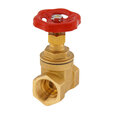Gate Valve Material Selection Guide
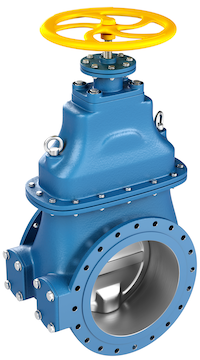
Figure 1: Bolted bonnet gate valve
Selecting the right gate valve material is crucial in the gate valve selection process. Various materials are used for the gate valve's body and seal. The material selection depends primarily on the media type and design temperature. This article discusses the common materials used in gate valves and how to find the right one for each application.
Table of contents
- Gate valve material selection
- Gate valve body materials
- PVC gate valves
- Brass gate valves
- Stainless steel gate valves
- Bronze gate valves
- Cast iron gate valves
- Cast steel gate valves
- Gate valve seal materials
View our online selection of gate valves!
Gate valve material selection
Gate valves are used in a wide range of applications, and they come in contact with diverse media. It is critical to consider the material used for valve construction to prevent premature valve failure and system delays during valve operation. Consider the following criteria to select the proper materials for a gate valve:
- Media composition (whether clear or filled with particles)
- Material compatibility with the media used
- How long the valve gets exposed to the media
- Operating pressure
- Service temperatures
- Effectiveness of coating on materials
- Material availability and cost
Gate valves are available in various materials, as discussed in the next section. Various organizations are committed to developing and maintaining standards for valves and materials in specific environments. For example, gate valves are specified by the American Petroleum Institute (API) and the National Association For Corrosion Engineers (NACE) for their suitability to work with heavy corrosive media.
Gate valve body materials
The various materials used to construct gate valve body are discussed below.
PVC gate valve
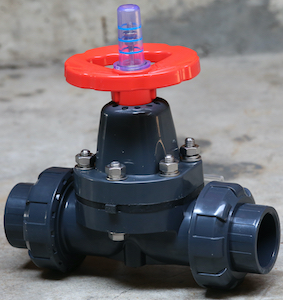
Figure 2: PVC gate valve
In a PVC gate valve, the valve's three main components, namely, the handle, housing, and gate, are made of PVC.
PVC gate valve features
- PVC gate valves are not damaged by freezing temperatures, and these valves can also withstand temperatures up to 60°C.
- Resistant to corrosion, making these valves ideal for chemical processing applications involving highly corrosive substances.
- PVC valves are affordable compared to metal valves.
- Excellent durability offering many years of reliable use.
- Available in a wide range of sizes.
PVC gate valve applications
PVC gate valves are a good low-cost solution for most flow control needs at home. These valves are durable and corrosion-resistant, hence widely used in aquatic environments. A few common applications are:
- Aquatics and aquaculture
- Landscaping and irrigation
- Tank drain valves and septic systems
- Indoor plumbing
- Spas
Brass gate valve
In applications where PVC gate valves would burst, it is a viable option to use gate valves made of metals or their alloys.
Brass gate valve features
- Brass gate valves work on 0-16 bar pressure range with media temperatures from -20°C to 120°C. Hence, they can withstand higher temperatures and pressure than PVC gate valves.
- Brass is stronger than PVC, but stainless steel is the strongest.
- Brass gate valves are costly compared to PVC gate valves, but less costly than stainless steel gate valves.
Brass gate valve applications
Brass can withstand more heat than PVC, making them an ideal choice for residential plumbing applications. Brass is extremely corrosion resistant, and the gate valves made of brass are ideal for manufacturing industries involving natural gas or potable water.
Stainless steel gate valve
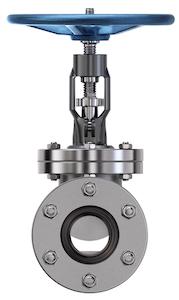
Figure 3: Stainless steel gate valve
Stainless steel gate valve features
- Stainless steel is the most durable, heat-resistant, and corrosion-resistant material when compared to brass and PVC.
- Withstands very high temperature (up to 800°C) and pressure. Stainless steel can withstand a wide range of temperatures (low to high) and pressure compared to brass and PVC.
- Used to manufacture gate valve body and internal parts
- Stainless steel gate valves have a simple body design enabling ease of repair, cleaning, and maintenance
- Used in applications involving liquid, gas, and steam
- Expensive compared to PVC, brass, and bronze gate valves
- Needs a large area for installation compared to brass or PVC
Stainless steel gate valve applications
Stainless steel is extremely durable and corrosion-resistant, hence used in marine and industrial applications. Some common applications are:
- Industrial applications like transporting natural gas and crude oil
- Slurry applications
- Drinking water applications at home as the material doesn’t leach into the water
Bronze gate valve
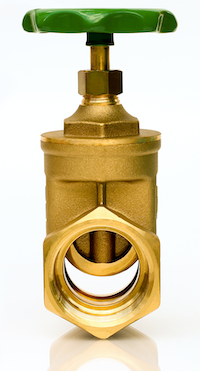
Figure 4: Bronze gate valve
Bronze gate valve features
- Excellent machinability, strength, and corrosion resistance
- Used to manufacture relatively small gate valves in low-pressure applications
- Bronze gate valves are typically used for water pipes and equipment pipelines of about 300 psi (20 bar) or less, and temperatures in the range -20° C -150° C.
- Higher cost compared to PVC, but less than brass and stainless steel
- Bronze has higher corrosion resistance than cast iron, but less than PVC or brass.
- Costlier than PVC but the cost is lower than brass or stainless steel.
Bronze gate valve applications
Bronze has high lead content; hence the material is not used frequently for drinking water applications. Bronze is commonly used for fluid control in low-pressure manufacturing industries and works well with steam, air, and gas. The material is also used in HVAC and marine applications.
Cast iron gate valve
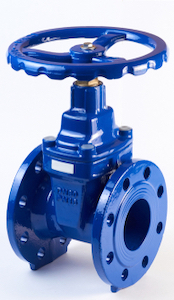
Figure 5: Cast iron gate valve
Cast iron gate valve features
- Cast iron has strength lying in between bronze and stainless steel
- Used to manufacture gate valve body
- Very low tensile strength and elongation properties, but good casting qualities
- Cast iron gets corroded over time.
- Less costly compared to all other valve materials.
Cast iron gate valve applications
Cast iron is used for constructing gate valves in low-pressure and low-temperature applications. The material is a popular choice for gate valves in water, wastewater, heating, ventilation, and air-conditioning (HVAC) units. Cast iron gate valves are extremely cheap, yet sturdy; hence these valves are more suitable for underground applications than steel valves.
Cast steel gate valve
Cast steel gate valve feature
- Casted carbon steel is a tough material, and the material is hard with excellent tensile strength and impact value.
Cast steel gate valve application
- Gate valves made of cast steel are commonly used in industrial plants for high temperature and pressure applications.
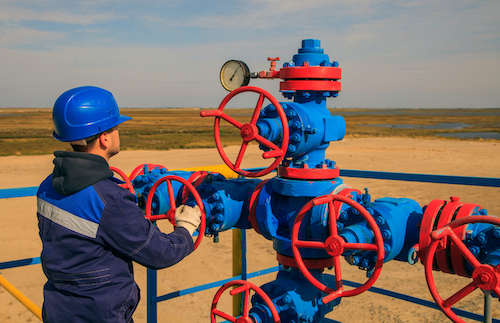
Figure 5: Cast steel gate valves used in industrial plants
Gate valve seal materials
Gate valve seats are available in two forms:
- Integrated-type: The gate valve seal is made of the same material as the valve body and it is integrated into the valve body.
-
Ring type: In this type, the gate valve seal is in the form of a ring that can be either pressed in or threaded which favors more variation. The seat can be coated with polytetrafluoroethylene (PTFE) to aid high-integrity shutoff. The ring-type seal is again classified into resilient-seated and metal-seated gate valves:
- Resilient seated gate valves: The gate is mostly composed of ductile iron and enclosed in a resilient elastomer material like ethylene propylene diene monomer (EPDM) forming a tight seal. These valves are preferred in water distribution systems because of the tight shut-off.
- Metal-seated gate valves: Ductile iron is commonly used as the gate material, and rings are made of bronze to ensure a watertight seal.
Read our chemical resistance guide article for more details on the compatibility of materials with different media.




